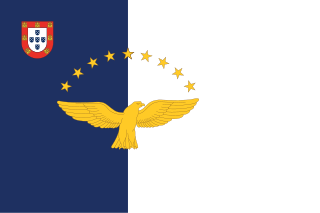
The Azores, officially the Autonomous Region of the Azores, is one of the two autonomous regions of Portugal. It is an archipelago composed of nine volcanic islands in the Macaronesia region of the North Atlantic Ocean, about 1,400 km (870 mi) west of Lisbon, about 1,500 km (930 mi) northwest of Morocco, and about 1,930 km (1,200 mi) southeast of Newfoundland, Canada.

Solanum mauritianum is a small tree or shrub native to South America, including Northern Argentina, Southern Brazil, Paraguay and Uruguay. Its common names include earleaf nightshade, woolly nightshade, flannel weed, bugweed, tobacco weed, tobacco bush, wild tobacco and kerosene plant.

Argyranthemum is a genus of flowering plants belonging to the family Asteraceae. Members of this genus are sometimes also placed in the genus Chrysanthemum.

Calotropis is a genus of flowering plants in the family Apocynaceae, first described as a genus in 1810. It is native to southern Asia and North Africa.

Cyanthillium is a genus of tropical plants in the ironweed tribe within the sunflower family.
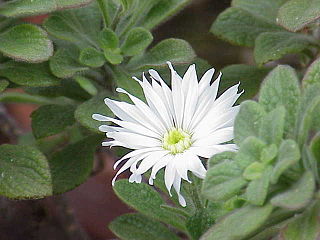
Commidendrum is a genus of trees and shrubs in the family Asteraceae endemic to the island of Saint Helena in the South Atlantic Ocean. The vernacular name is gumwood or scrubwood.

The Cichorieae are a tribe in the plant family Asteraceae that includes 93 genera, more than 1,600 sexually reproductive species and more than 7,000 apomictic species. They are found primarily in temperate regions of the Eastern Hemisphere. Cichorieae all have milky latex and flowerheads that only contain one type of floret. The genera Gundelia and Warionia only have disk florets, while all other genera only have ligulate florets. The genera that contain most species are Taraxacum with about 1,600 apomictic species, Hieracium with about 770 sexually reproducing and 5,200 apomictic species, and Pilosella with 110 sexually reproducing and 700 apomictic species. Well-known members include lettuce, chicory, dandelion, and salsify.
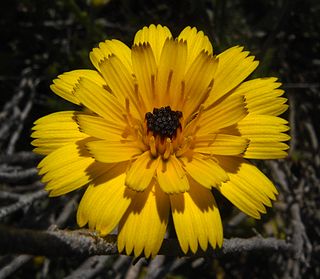
Tolpis is a genus of flowering plants in the tribe Cichorieae within the family Asteraceae. It is native to Africa, Southern Europe, the Middle East and Macaronesia. Many species are limited to the Canary Islands.

Solidago gigantea is a North American plant species in the family Asteraceae. Its common names include tall goldenrod and giant goldenrod, among others.

Tolpis barbata is a species of flowering plant in the family Asteraceae known by the common name European umbrella milkwort. It is native to southern Europe, including the Mediterranean, and it is known in many other places as an introduced species and a common weed, such as in California and New South Wales.

Molineria is a genus of flowering plants. In the APG III classification system, it is placed in the family Hypoxidaceae. It is native to Southeast Asia, China, the Indian Subcontinent, Papuasia, and Queensland.
- Molineria capitulata(Lour.) Herb. - China, Indian Subcontinent, Southeast Asia, Papuasia, Queensland; naturalized in Mexico, Central America, West Indies, Argentina, Mauritius, Réunion
- Molineria crassifoliaBaker - Nepal, Assam, Bhutan, Sikkim, Yunnan, Arunachal Pradesh
- Molineria gracilisKurz - southern China, Assam, Bhutan, Nepal, Cambodia, Thailand, Vietnam
- Molineria latifolia(Dryand. ex W.T.Aiton) Herb. ex Kurz - China, Bangladesh, Indochina, Philippines, western Indonesia, Borneo
- Molineria oliganthaC.E.C.Fisch. - Assam
- Molineria prainianaDeb - Assam, Bhutan
- Molineria trichocarpa(Wight) N.P.Balakr. - southern India, Sri Lanka
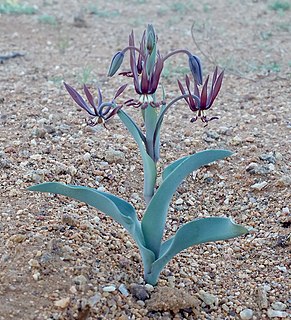
Ornithoglossum is a genus of plants native to southern Africa, some of which are widely cultivated as ornamentals. Nine species are currently recognized, as of April 2014:
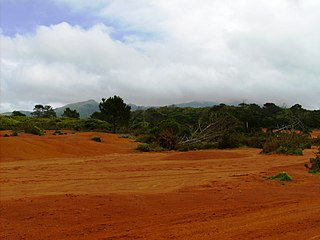
The Protected Landscape of Barreiro da Faneca is a geological region and protected landscape of the Portuguese island of Santa Maria, Azores. The protected area is given its name by the Barreiro da Faneca, nicknamed the "Red Desert of the Azores", an arid and clayey landscape formed during the Pliocene, unique not only to the island but to all of Portugal.
Tolpis farinulosa is a species of flowering plants of the family Asteraceae. The species is endemic to Cape Verde. It is listed as endangered by the IUCN. Its local name is mato-branco, a name that may also refer to the species Phagnalon melanoleucum and Verbascum cystolithicum.
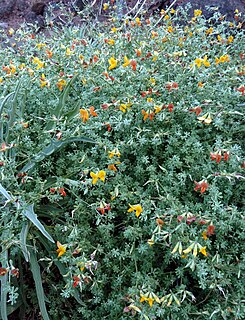
Lotus glaucus is a species of flowering plant in the family Fabaceae, native to Madeira and the Salvage Islands. It is a perennial herbaceous plant with leaves made up of five leaflets. Its flowers are usually orange on opening. Lotus tenellus is included in a more broadly circumscribed L. glaucus by some authors, which extends its distribution to the Canary Islands.

Symphyotrichum patens, commonly known as late purple aster or spreading aster, is a perennial, herbaceous plant found in the eastern United States.

Praia Islet is a highly vegetated uninhabited islet located approximately 1.5 kilometres away from the town of Praia off the eastern coast of the island of Graciosa in the Portuguese archipelago of the Azores. Along with Baixo Islet to its south, Praia Islet is one of two main breeding places of Monteiro's storm petrel, an endemic marine bird of the Azores.
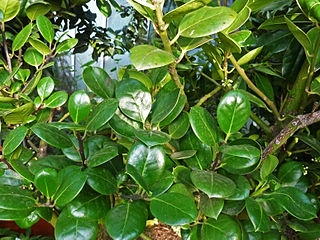
Ilex perado, the Macaronesian holly, is a species of holly endemic to Macaronesia, distributed throughout the Azores, Madeira and Canary islands. It is an important component of the natural high-altitude Macaronesian rainforest, known as 'laurisilva', found mostly at 500 to 1,200 m altitude but it also appears in forest formations at lower altitudes. Many of the subspecies have been classified as threatened, probably because of very small population sizes, and are protected by local, national and regional legislation.

Sonchus ustulatus, also known as a leituga, is a species of herb in the Asteraceae family. It has been found near or on islands owned by Portugal and Spain. It produces oxygen and grows to be around 0.2 meters.



















